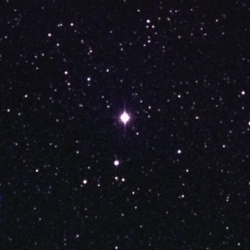
RS Ophicuchi by John Chumack
On February 12, Universal time, two Japanese observers, Kiyotaka Kanai and Hiroaki Narumi, noticed that a star normally too dim to be seen by the unaided eye in the constellation of Ophiucus had suddenly grown much brighter. It was now about as visible as the star in the handle of the Little Dipper that is nearest Polaris, the northern pole star. The star is named RS Ophicuchi and it has done this before in 1898, 1933, 1945 (this date is suspected), 1958, 1967 and 1985.
RS Ophicuchi is a double star – one’s a red giant the other’s a white dwarf. Material from the red giant is constantly being pulled toward the dwarf where it accumulates to form a flat, ring-like disk that reaches to its surface. Over time the pressure within and temperature of the accretion disk increases until it’s enough to ignite a thermonuclear explosion of unimaginable proportions. We see that flash of brilliance, this one was located three thousand light years in the distance, as a nova.
Novas only happen in stellar pairs and represent the aches and pains of older stars. Unlike supernova, which occur in single, massive stars, novas seldom result in the annihilation of either.
As of last weekend, the brilliance of the nova had started to fade and will continue to do so gradually for quite some time. During the 1985 episode, it took almost a year and a half before the stars had returned to their normal faintness as seen here on Earth. Of course, now that the previous material has been destroyed, new material will slowly start to re-accumulate on the dwarf star and begin a new cycle that will lead up to the next explosion.
John Chumack took this picture of RS Ophicuchi, three days after its discovery from a remotely controlled observatory in New Mexico. John took sixteen 30 second pictures then combined them to create this full color image that is the equivalent of a single eight minute exposure. This image covers a sky area that is approximately four full moons wide using a Takahashi Sky90 telescope and a SBIG three mega-pixel camera.
Do you have photos you’d like to share? Post them to the Universe Today astrophotography forum or email them, and we might feature one in Universe Today.
Written by R. Jay GaBany
